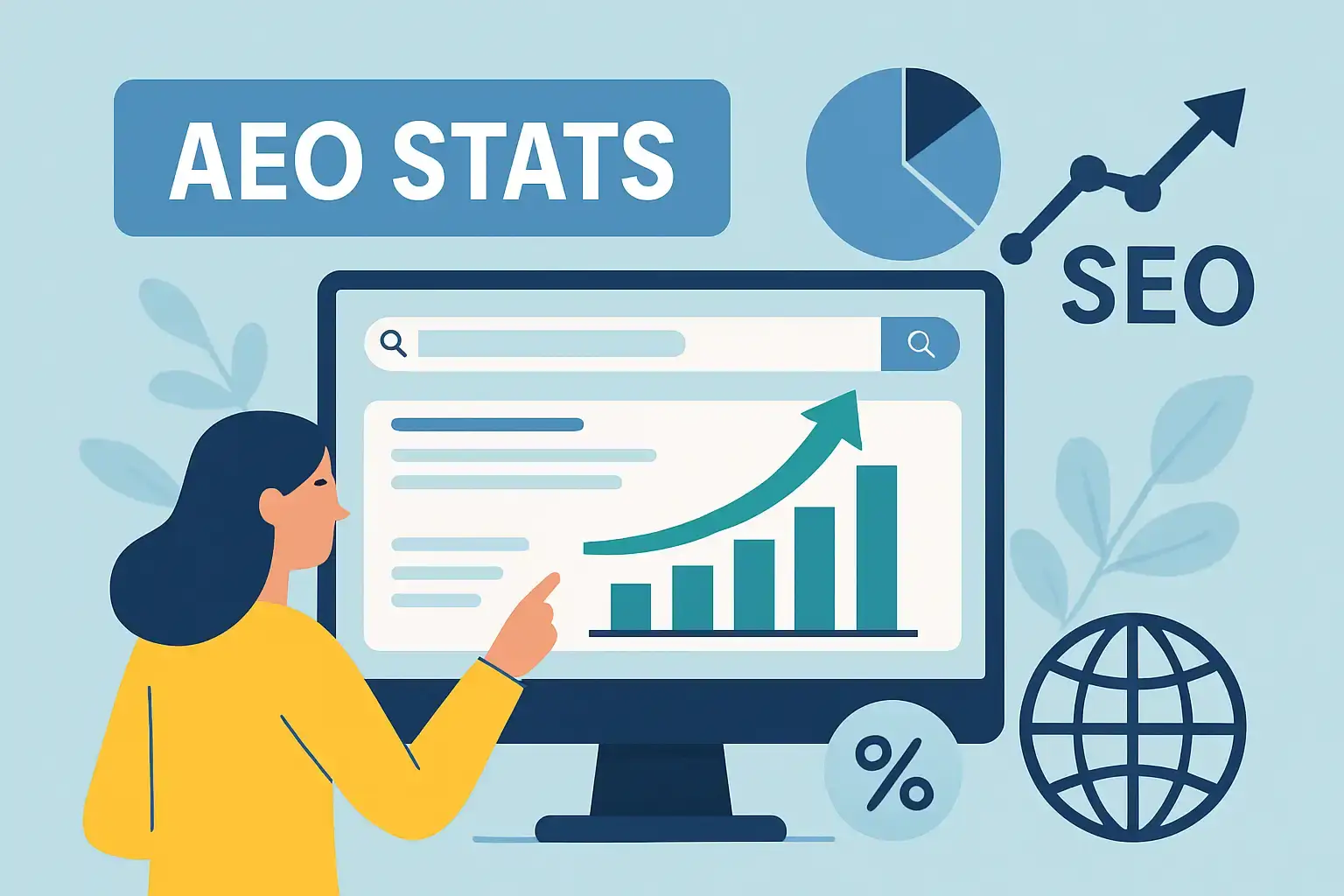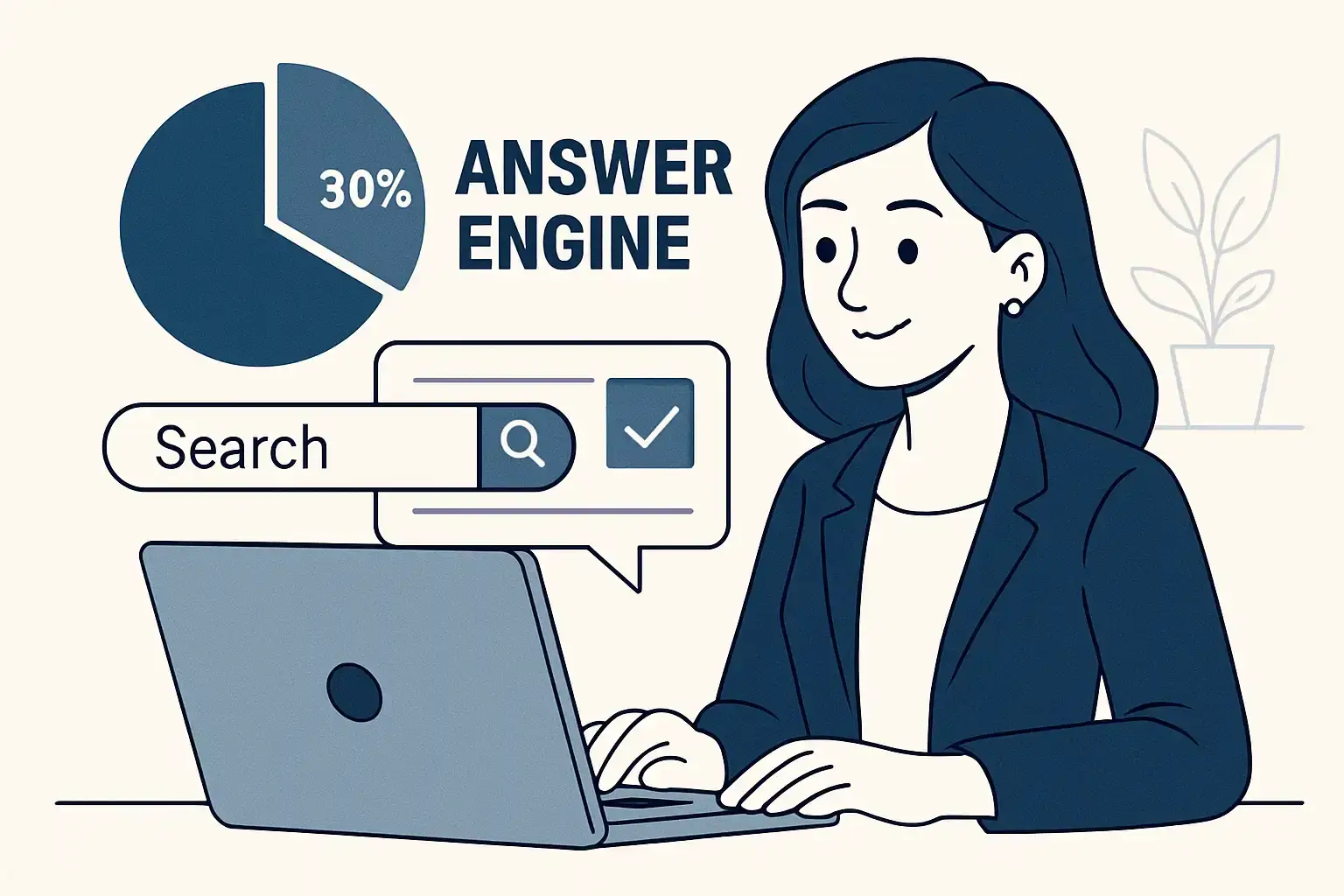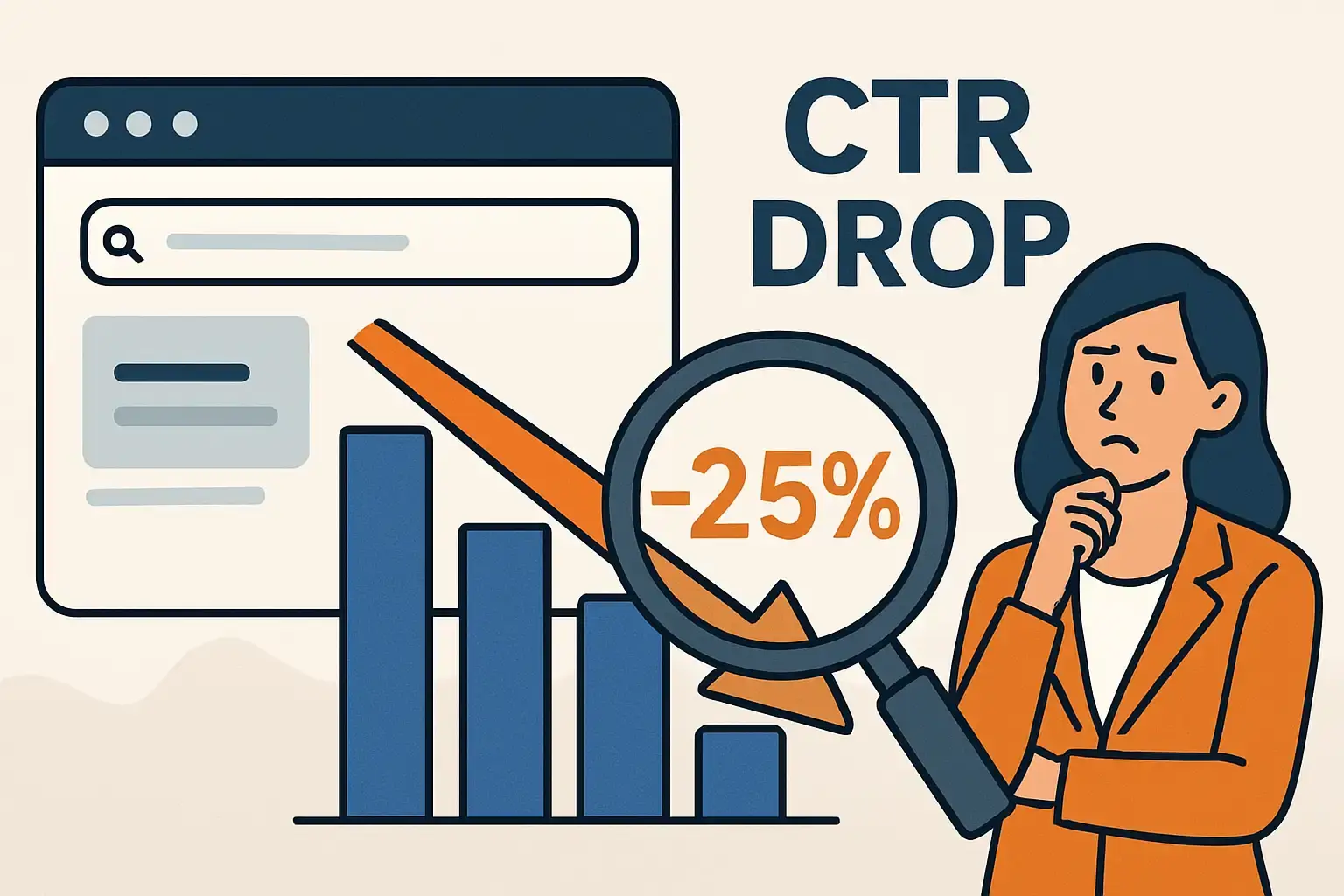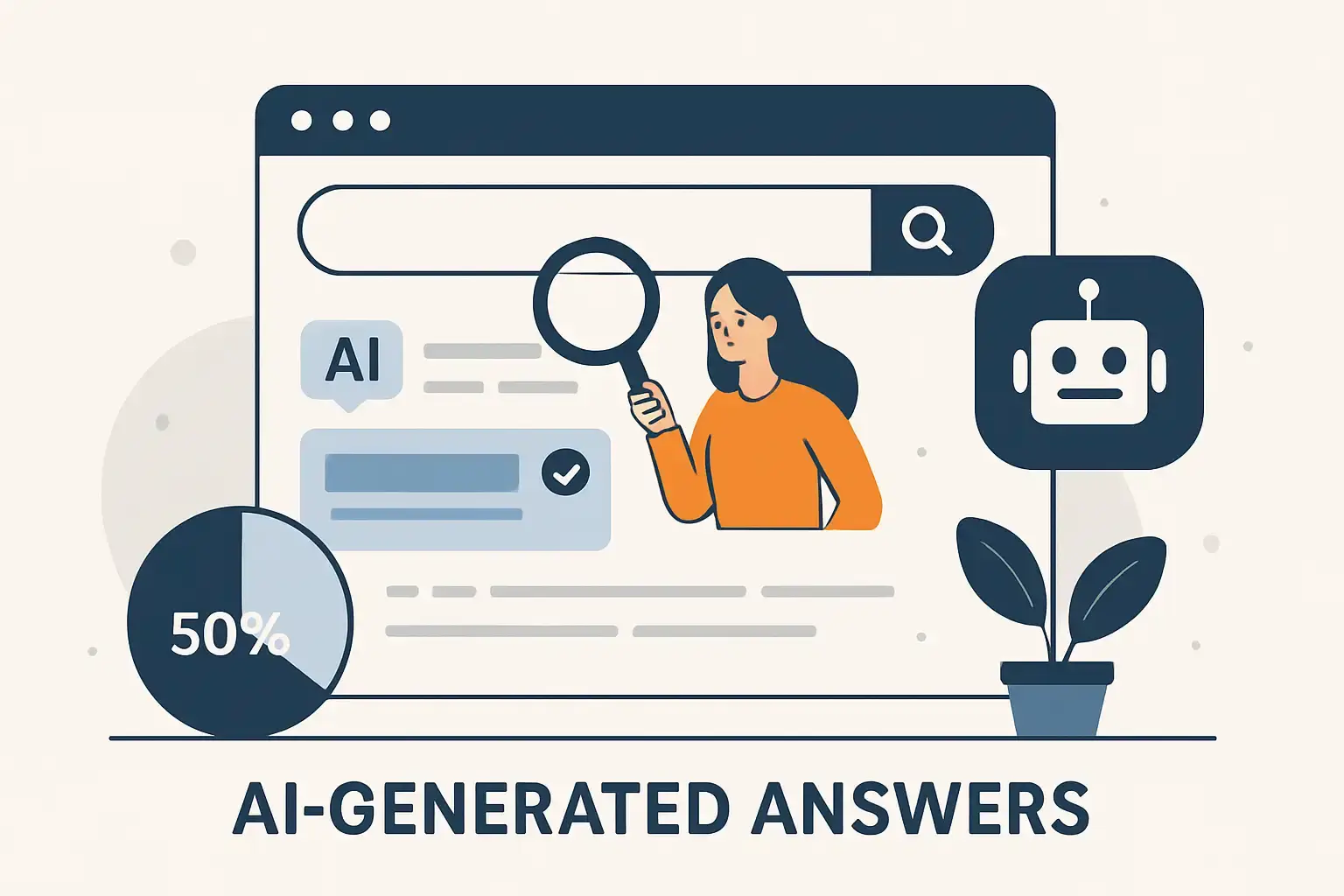Answer Engine Optimization (AEO) Stats: Impact on Traffic and SEO

TL;DR — Answer Engine Optimization (AEO) is transforming the search landscape by focusing on optimizing content for AI-driven answer engines like voice assistants and chatbots, which now handle about 30-40% of search queries. This shift impacts traditional SEO, reducing click-through rates but increasing visibility in featured snippets and answer boxes. Content formats such as FAQs, lists, and structured data are crucial for success, and understanding how answer engines change SEO is vital for staying competitive in 2025. As AI-powered tools like Google SGE and LLMs become more prevalent, integrating AEO strategies ensures your content remains relevant and visible in this evolving digital environment.
Table of Contents
What Is Answer Engine Optimization (AEO) and Why Does It Matter?
If you’ve been hearing a lot about AEO lately and wondering how it fits into your SEO strategy, you’re not alone. Answer Engine Optimization (AEO) is quickly becoming a game-changer in the digital marketing world, and here’s why it deserves your attention.
What Exactly Is AEO, and How Does It Differ from Traditional SEO?
Think of traditional SEO as a race to rank your webpage higher on search engine results pages (SERPs) by targeting keywords and building backlinks. It’s about getting your site noticed among a sea of links.
AEO flips that script. Instead of just aiming for a spot on the list, AEO focuses on optimizing your content so AI-driven answer engines—like voice assistants, chatbots, and advanced AI models—can understand and deliver your content as a direct answer. This means structuring your content for natural language queries, crafting clear, concise responses, and targeting featured snippets or voice search results.
In other words, while SEO is about being found, AEO is about being understood and being the answer. For a full detailed guide, see this Ultimate AI Search Optimization Guide (AEO, GEO, AIO).
Why Are Marketers and SEOs Talking About AEO, GEO, LLMO, and AIO Now?
The search landscape is shifting fast. With AI-powered tools like ChatGPT, Bard, and other generative models becoming the go-to for quick, conversational answers, the old ways of SEO aren’t enough anymore.
Here’s the deal:
- GEO (Generative Engine Optimization) focuses on optimizing content for AI that generates new responses.
- LLMO (Large Language Model Optimization) is about tailoring content so large language models can interpret and use it effectively.
- AIO (AI Optimization) covers the broader strategy of making your content AI-friendly across platforms.
All these buzzwords point to one thing: AI is changing how people search and how answers are delivered. If you want your content to show up in these AI-driven answer boxes or voice responses, you need to adapt.
By understanding and implementing AEO, you’re not just keeping up—you’re positioning yourself ahead of the curve, ensuring your content gets the spotlight it deserves in this new era of search.
Stat #1: 30% of Online Searches are Handled by Answer Engines

You might have noticed that traditional search results aren’t the only game in town anymore. In fact, recent studies show that 30% of online searches are now handled by answer engines or AI-powered assistants instead of classic search listings. That’s a huge chunk of traffic shifting away from the old “10 blue links” model.
Why is this happening? More people are using voice search, smart assistants, and AI chatbots to get quick, direct answers. Think about how often you ask Siri or Alexa a question and get an immediate response without clicking through to a website. Platforms like Google Assistant, Siri, Alexa, and AI chatbots are becoming the go-to sources for instant info, which means users don’t always need to visit traditional sites anymore.
Who’s Leading the Charge?
The shift toward answer-based results isn’t random—it’s driven by some major players:
|
Platform |
How They Deliver Answers |
|---|---|
|
|
Featured snippets, AI-powered Bard |
|
Microsoft Bing |
Integration with OpenAI’s ChatGPT |
|
Amazon Alexa |
Voice assistant providing conversational answers |
|
Apple Siri |
Voice assistant with direct response capabilities |
|
Google Assistant |
Voice and AI-powered direct answers |
Plus, AI chatbots embedded in messaging apps and standalone platforms are quickly becoming significant players. They prioritize conversational, direct responses over traditional link-based results, making it easier for users to get what they want fast.
Tip: If you’re still focusing solely on classic SEO tactics, it’s time to rethink your strategy. Optimizing for answer engines means crafting content that’s concise, clear, and structured to be easily parsed by AI assistants. This can boost your visibility in featured snippets and voice search results, capturing that growing slice of search traffic.
Understanding this shift is crucial for staying ahead. The rise of answer engines means your content strategy needs to evolve—not just to rank, but to answer effectively.
Stat #2: Traditional Organic Click-Through Rates (CTR) Can Drop by 25% Due to AEO

When it comes to Answer Engine Optimization (AEO), you might notice something surprising: your traditional organic click-through rates (CTR) often take a hit. Why? Because users are getting their answers right there on the search or AI assistant interface, without needing to click through to your site. This shift can feel like a blow to your traffic numbers, but it’s not the whole story.
How AEO Changes the CTR Game
AEO tends to reduce the overall CTR for regular search listings. Instead of scrolling through ten blue links, users see featured snippets, answer boxes, or direct responses powered by AI. This means fewer clicks—but more visibility in prime real estate on the results page.
Here’s the kicker: when your content is optimized for AEO, appearing in these answer boxes can actually boost your brand’s authority and trustworthiness. The traffic you do get tends to be more engaged and ready to convert, because those users are often looking for deeper insights or to take action after seeing the quick answer.
|
Aspect |
Traditional SEO CTR |
AEO-Optimized CTR |
|---|---|---|
|
Overall Click-Through Rate |
Higher, but more scattered |
Lower, but more targeted |
|
User Engagement |
Varies widely |
Higher quality, conversion-ready |
|
Visibility |
Standard listings |
Featured snippets & answer boxes |
Do Users Stay or Click Through?
You might wonder: are users sticking around on the answer engine, or do they still click through to websites? The answer depends on the query type:
- Simple or factual queries: Users often stay put, satisfied with the quick answer.
- Complex or transactional queries: Users usually click through for more detailed info or to complete a purchase.
The trend is clear—more people prefer staying within the answer engine environment for fast answers, but your site remains crucial for deeper engagement.
Pro tip: Focus your AEO strategy on capturing those featured snippets and answer boxes. Even if your CTR dips, the quality of visitors who do click through will improve, leading to better conversion rates and stronger brand loyalty.
Understanding this balance helps you adapt your content strategy to the evolving search landscape—making sure you’re not just chasing clicks, but meaningful interactions.
Stat #3: Pages Optimized for Featured Snippets See Up to 35.1% Higher CTR

When it comes to Answer Engine Optimization, not all content is created equal. You want your content to be the one that answer engines pick to showcase, so understanding which formats perform best is key.
What Content Formats Perform Best for Answer Engines?
Answer engines love content that’s:
- Concise and well-structured: Think lists, tables, FAQs, and how-to guides. These formats break down information into bite-sized, easy-to-digest pieces.
- Clear and direct: Use headings, bullet points, and straightforward answers to common questions. This helps answer engines quickly identify the best snippet to display.
- Multimedia-enhanced: Images, videos (especially with transcripts), and schema-marked data boost your chances of being selected. Visuals and rich media provide context and improve user engagement.
- Voice-friendly: Content that mimics natural, conversational language performs well, especially as voice search grows.
How Do Structured Data and Featured Snippets Boost Your AEO Success?
Structured data, or schema markup, is your secret weapon. It tells answer engines exactly what your content is about, making it easier for them to pull precise answers.
Featured snippets are the ultimate AEO win — they highlight your content right at the top of search results as the best answer. To snag a featured snippet:
- Provide clear, authoritative answers.
- Use well-organized content with proper headings.
- Format your answers in lists, tables, or concise paragraphs.
Pro tip: According to recent studies, pages optimized for featured snippets see up to a 35.1% increase in click-through rates. So, investing time in structured data and snippet-friendly content pays off big.
By focusing on these content types and optimization tactics, you’ll position yourself to ride the wave of AEO and get your content in front of more eyes — and ears.
Stat #4: Sites Can See 18-64% Drop in Organic Traffic Due to Answer Engines Answering Directly

When it comes to Answer Engine Optimization (AEO), you might be wondering: Is my website traffic going up or down? And what about conversions? The truth is, AEO shakes things up in ways that aren’t always obvious at first glance.
How Much Website Traffic Is Lost or Gained Due to AEO?
The impact of AEO on your traffic depends a lot on your industry and the types of queries your audience uses. Some sites have seen a 18-64% drop in organic traffic because users get their answers right from the search results or voice assistants—no click needed. That can feel like a hit.
But here’s the flip side: if you nail your AEO strategy, you can actually attract higher-quality traffic. How? By appearing in featured snippets, voice search results, or other answer engine features that bring in visitors who are more likely to engage deeply with your content.
Tip: Focus on optimizing for intent and providing value that goes beyond the quick answer. This way, even if some users get their info instantly, others will be motivated to click through for more detailed insights.
Does AEO Help or Hurt Conversions and Lead Generation?
AEO is a double-edged sword for conversions. On one hand, delivering direct answers builds trust and positions your brand as an authority—both great for boosting conversion rates among users who do visit your site.
On the other hand, if users find everything they need right in the answer engine, they might never land on your page, which means fewer chances to capture leads or drive sales.
The key is balance. Provide enough upfront value to satisfy quick questions but include compelling calls-to-action or deeper content that encourages users to explore your site further.
|
AEO Impact Aspect |
Potential Positive Effect |
Potential Negative Effect |
|---|---|---|
|
Website Traffic |
Attracts high-intent visitors via snippets and voice search |
Overall organic traffic volume may decline |
|
Conversions & Leads |
Builds trust and authority, increasing conversion rates |
Reduced site visits can limit lead capture |
By understanding these nuances, you can tailor your AEO approach to not just survive but thrive in this evolving search landscape.
Stat #5: Over 50% of All Searches Will be Influenced by AI-Generated Answers

The future of Answer Engine Optimization (AEO) and its related fields—GEO, LLMO, and AIO—is shaping up to be a game-changer for digital marketers like you. The latest stats reveal a clear trend: AI-driven answer engines are rapidly capturing more search traffic, and by 2025, over half of all searches will be influenced by AI-generated answers. This means that traditional SEO alone won’t cut it anymore; integrating AEO into your strategy is becoming essential.
What the Numbers Tell Us
- 50%+ of searches influenced by AI answers by 2025
- Marketers are increasingly investing in structured data to help AI understand content better
- There's a growing focus on conversational, concise content that fits voice and AI search formats
- The line between AI and search is blurring, making AEO a core part of digital marketing
How to Get Ready for the Next Wave
You might be wondering how to stay ahead in this fast-evolving landscape. Here’s what you can do:
- Embrace AI-friendly content: Use structured data markup extensively to help answer engines parse your content accurately.
- Craft conversational content: Write as if you’re answering a question directly—short, clear, and engaging.
- Optimize for voice search: Think about how people speak, not just type, their queries.
- Keep an eye on AI updates: Platforms like Google and Bing regularly tweak their AI algorithms—stay informed and adapt quickly.
- Invest in analytics tools: Use tools that track AI-driven search behavior to refine your strategy continuously.
- Focus on user intent: Go beyond just answering questions—provide value that keeps users engaged and drives conversions.
Pro tip: According to recent industry surveys, marketers who integrated structured data and conversational content saw a 30% increase in featured snippet appearances within six months. This kind of visibility can significantly boost your organic traffic and brand authority.
By preparing now, you’re not just reacting to change—you’re leading it. Remember, the future of search is about delivering precise, helpful answers powered by AI, and your content can be right at the forefront.
Keep experimenting, stay curious, and you’ll navigate these changes with confidence and success!
Frequently Asked Questions (FAQ)
What is the difference between AEO and traditional SEO in 2025?
AEO (Answer Engine Optimization) differs from traditional SEO by prioritizing content that AI answer engines can easily interpret and display as direct answers, such as featured snippets and voice responses. While traditional SEO focuses on ranking higher on SERPs through keywords and backlinks, AEO emphasizes structuring content for AI understanding, which is increasingly important as answer engines like Google SGE and LLMs dominate search queries in 2025.
How does AEO impact website traffic and conversions?
AEO can lead to a decrease in organic traffic because users often get their answers directly from answer engines or voice assistants without clicking through to websites. However, it can also attract higher-quality, intent-driven visitors who are more likely to convert. Balancing optimized snippets with compelling calls-to-action on your site is key to maintaining and improving conversions in the era of answer engine optimization.
What content types perform best for answer engine optimization?
Content that performs best for AEO includes concise, well-structured formats like FAQs, lists, tables, and how-to guides. Using schema markup and structured data enhances visibility in answer boxes and featured snippets. Additionally, voice-friendly, conversational content and multimedia elements like videos and images improve chances of being selected by answer engines, aligning with the latest AEO data and search trends.
What are the future trends in AEO and related search optimization strategies?
Future trends in AEO include a growing influence of AI-generated answers, with over 50% of searches expected to be AI-driven by 2025. Marketers are investing more in structured data, conversational content, and voice search optimization. Staying ahead involves understanding how answer engines change SEO, leveraging LLMO search trends, and continuously adapting to new AI updates and AIO stats for marketers to maintain visibility and relevance.
How can I prepare my content for AEO and LLMO search trends?
To prepare for AEO and LLMO search trends, focus on creating conversational, concise content optimized with structured data and schema markup. Emphasize answering common questions clearly and directly, and incorporate multimedia to enhance context. Monitoring the latest AEO data and LLMO search trends helps refine your strategy, ensuring your content remains AI-friendly and competitive in the evolving search landscape.
